 Hornbuckle leads a team of interdisciplinary researchers focused on identifying sources of airborne PCBs and how they affect human health. (Photo courtesy of the University of Iowa)
Hornbuckle leads a team of interdisciplinary researchers focused on identifying sources of airborne PCBs and how they affect human health. (Photo courtesy of the University of Iowa)Approaches for studying airborne exposure to polychlorinated biphenyls (PCBs) — and helping communities reduce such exposure — were discussed by Iowa Superfund Research Program (ISRP) Director Keri Hornbuckle, Ph.D., during her Feb. 4 Keystone Science Lecture. The NIEHS-funded program is housed at the University of Iowa.
PCBs are a large group of chemicals that persist in the environment. They have been associated with conditions such as diabetes, liver toxicity, skin ailments, and immune, neurological, and respiratory issues. The substances can be found in products ranging from adhesives and paints to insulation and electrical equipment. Although the chemicals were banned in the U.S. in 1979, potentially harmful exposure to PCBs is an ongoing concern, according to Hornbuckle.
Potentially dangerous byproducts
A group of 209 PCB mixtures known as Aroclors were produced by the company Monsanto in the middle of the 20th century for use in electrical transformers, fluorescent light ballasts, hydraulic fluid additives, building materials, and flame retardants. Sale of Aroclors was banned by the U.S. Environmental Protection Agency in 1975. However, non-Aroclor PCBs continue to be manufactured, largely as byproducts of certain industrial processes, noted Hornbuckle.
 Airborne PCB exposure increases on hot days, noted Hornbuckle. (Photo courtesy of Tom Wang / Shutterstock.com)
Airborne PCB exposure increases on hot days, noted Hornbuckle. (Photo courtesy of Tom Wang / Shutterstock.com)She explained that exposures are ubiquitous in the U.S. because of how the substances vaporize into the air, especially on hot days. Although it has been assumed that exposure comes primarily through diet because of how PCBs bioaccumulate in fish and other animals, it is now known that inhalation is another important route of exposure. Hornbuckle, who leads the ISRP Analytical Core, discussed how research methods optimized for assessment of the chemicals have provided new insights about sources of airborne PCBs, exposures, and potential for remediation.
Quantifying exposure
Hornbuckle’s team developed a set of sampling and analytical methods to provide the highest quality PCB data. For example, they use an instrumental method for detection and quantification of the chemicals that uses triple quadrupole mass spectrometry. The approach allows scientists to measure PCBs with a level of accuracy and precision comparable to that provided by high-resolution mass spectrometry but at lower cost.
According to Hornbuckle, the method enables her team to better understand sources of airborne PCB exposure. She noted that the scientists study the release of the substances in cities, rural areas, and school classrooms.
Beginning in 2009, ISRP Project 4 began sampling for airborne PCBs in Chicago, and researchers discovered the prevalence of airborne non-Aroclor PCBs. The scientists determined that past systems for measuring the chemicals had been developed using Monsanto mixtures, which meant that modern PCBs produced as byproducts of manufacturing had gone unnoticed.
Interestingly, one driver of PCBs being emitted into the air involves the heat of the day, not proximity to manufacturing sites.
“The variability of PCBs across the city of Chicago is mostly driven by temperature,” Hornbuckle explained. “The hotter it is, the more they’re released into the air.”
Another surprising finding is that living in rural areas does not equate to lower levels of PCB exposure. In addition, some children experience the highest levels of PCBs in their classrooms.
Reducing health risks
“Many American schools were built in the middle part of the last century, and PCBs were widely added to building materials because they do make resilient materials that don’t need replacement — think lighting, window caulking, masonry joints, paint, and carpets,” Hornbuckle said.
Mitigating the risk of exposure in schools is challenging, she noted. There is no federal program to remove PCB contamination once it is discovered, and schools with resources to address the problem are likely in high-income areas. Because expensive remediation — removal of the substances — is often not feasible in low-income districts, more vulnerable populations can experience the most exposures.
Hornbuckle suggested that school districts can target the worst exposure areas by testing for PCBs on a room-by-room basis.
She said that the state of Vermont is undertaking such a campaign in its schools — combing for sources of PCB exposure, room by room. And a side benefit of many schools around the country updating their ventilation and air filtration systems to slow the spread of COVID-19 is that these measures lower exposure to PCBs as well.
“When you’re trying to determine toxicological risk and opportunities for remediation, some level of focus is needed,” Hornbuckle said. “It’s important to create a strategy for remediation that is cost-effective and that allows for [exposure] measurement when you’re done.”
During a lively Q&A discussion, NIEHS and National Toxicology Program Director Rick Woychik, Ph.D., noted that he grew up in northeastern Wisconsin on the Fox River, which became contaminated with PCBs.
“It is rather sobering to realize just how contaminated that area was,” he said, adding that in many places, PCBs are just one set of chemicals to which people are exposed.
“A major research challenge is to better understand how all of these exposures can influence health and disease,” noted Woychik.
Citations:
Jahnke JC, Martinez A, Hornbuckle KC. 2022. Distinguishing Aroclor and non-Aroclor sources to Chicago air. Sci Total Environ; doi:10.1016/j.scitotenv.2022.153263 [Online 20 January 2022].
Bannavti MK, Jahnke JC, Marek RF, Just CL, Hornbuckle KC. 2021. Room-to-room variability of airborne polychlorinated biphenyls in schools and the application of air sampling for targeted source evaluation. Environ Sci Technol 55(14):9460–9468.
(Kelley Christensen is a contract writer and editor for the NIEHS Office of Communications and Public Liaison.)









